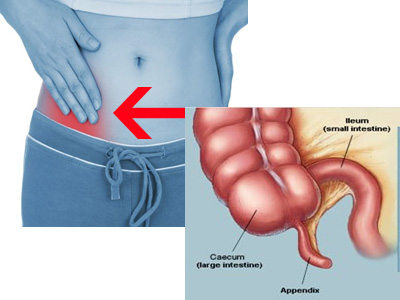What is Appendix?
With evolution of humans from apes, the tail disappeared gradually leaving behind a small appendage called the appendix. This is a thin narrow tube around 3- 4 inches long lying at the junction of the small intestine and the large intestine on the right side of the abdomen. It is known to produce mucus that enters the large intestine.
What is Appendicitis?
Appendicitis is a condition in which there is swelling or inflammation of the appendix, and is regarded as a medical emergency. It calls for quick diagnosis and surgery to remove the appendix. If the condition is left untreated for long, the swollen appendix will burst eventually, and infectious material from the burst appendix can enter the abdominal cavity.

What are the possible causes for Appendicitis?
- Faeces blocking the appendix
- Foreign objects rubbing into the appendix
- Tumour in the abdominal region
- In general when the appendix is blocked, bacterial growth in the organ increases causing swelling and infection.
- Appendicitis can occur at any age of the individual, although it’s more common in teenagers and the 20s crowd.
Signs and symptoms of Appendicitis
For most teenagers and youngsters, the most prominent symptom is a sharp abdominal pain that starts near the navel and extending to the lower right side of the abdominal region. The pain may be occasional in the beginning and over time, can last over 12 to 24 hours. The pain is severe when the patient turns around while lying down, is panting, coughing or sneezing. However, the same symptoms may not be present in children, elderly patients, married or pregnant women, making it more difficult to diagnose the condition.
Also Read:Early warning signs of appendicitis, and treatment
- A comprehensive list of symptoms includes:
- Sharp pain in the lower right side of the abdomen
- Abdominal swelling
- Nausea and vomiting
- Loss of appetite
- High fever (over 99 degree Fahrenheit)
- Gaseous or bloated up feeling
- Painful or difficult urination
- Stomach cramps
- Constipation
- Diarrhea
- Severe pain after eating or consuming antacids/digestive pills
- Diarrhea for more than 5 days in adults and more than days in children
How is Appendicitis diagnosed?
Most doctors look for the above symptoms, followed by gently stabbing their hand in the lower right side of the abdomen. If the patient feels a sharp pain, appendicitis is suspected. Further, the following tests and diagnostics are done to get a complete picture:
- Blood test: In most cases of appendicitis, the WBC count is higher
- LFT or Liver function tests
- Kidney function tests
- Ultrasound of the Abdominal region
- CT scan of the Abdominal region
Also Read: Acute Abdomen Pain – A Pandora’s Boxt
What is the treatment for Appendicitis?
quick surgery to remove the appendix is the best option for most patients. Unlike the past when incisive surgery was done, today, a laparoscopic surgery is what is followed. This ensures patients heal quickly and their routine is not disturbed for too long.
In case of a ruptured appendix, also called peritonitis, the appendix is removed through open surgery or laparotomy.
If an abscess is formed around the ruptured appendix, the pus is drained out from the abscess cavity over a duration of 2 weeks, during which time, the patient is given antibiotics
Are there any precautions to be taken?
Once you notice any of the above-mentioned symptoms of appendicitis, consult a doctor immediately
Once appendicitis is confirmed, surgery must be done at the earliest, else the risk of ruptured appendix is high
Considering that laparoscopic surgery is the most common option used today, there is not much of pre-operative or post-operative care to be taken

Article by Dr. Kannan. D, M.S, M.CH(GASTRO), FRCS(GLASG)
Consultant Surgical Gastroenterology, Kauvery Hospital

